The Digital Shift in European Travel
Schengen Visa Digitalization 2025 marks a groundbreaking transformation in how millions of travelers apply to visit Europe.
The traditional paper-based visa process — filled with embassy visits, printed documents, and long queues — is finally moving online.
Starting mid-2025, the European Union will officially launch the digital Schengen visa platform, allowing applicants from over 100 countries to submit their visa applications, pay fees, and upload biometric data entirely online.
This move represents more than just convenience — it’s a step toward a secure, unified, and transparent travel future for everyone heading to the Schengen Area, which covers 29 European countries.
“The goal is simple — to make Schengen travel easier, safer, and smarter for everyone.” — European Commission, 2025
1. What Is Schengen Visa Digitalization 2025?
The Schengen Visa Digitalization 2025 program is the EU’s initiative to replace the traditional visa sticker and manual paperwork system with a fully digital visa platform.
This means:
- No more physical visa stickers on your passport
- No need for repeated embassy appointments (except first-time biometric capture)
- Secure online payment and document submission
- A single EU-wide digital database for visa verification
Once implemented, travelers will receive a digital visa — a secure QR-coded authorization linked to their passport — making border checks smoother and faster.
2. How the New Schengen Visa Digitalization 2025 Platform Works
Here’s how the online Schengen visa system will function once launched in 2025:
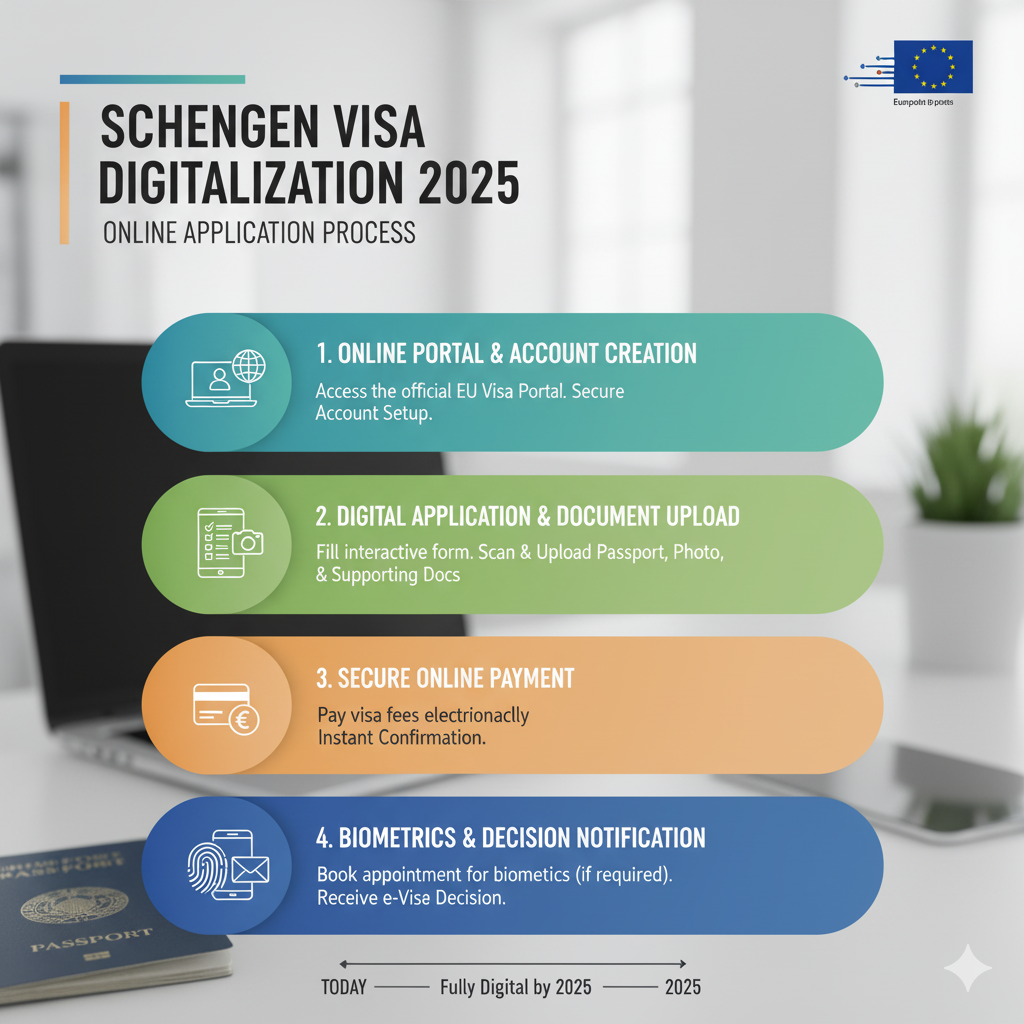
- Create an account on the official EU Digital Visa Portal (linking to https://travel-europe.europa.eu/visa-online
- Fill out your application online
- Upload documents — passport, travel insurance, itinerary, proof of accommodation, etc.
- Submit biometrics (only required for first-time applicants; data valid for 59 months)
- Pay online securely using credit/debit cards
- Receive confirmation and digital visa directly in your account
- This modernization ensures faster processing, fewer rejections, and greater transparency across all Schengen countries.
Source: Official EU Commission Schengen Digitalization Press Release
3. Why the EU Is Going Digital: The Bigger Picture
The digital visa isn’t just about convenience — it’s about security and consistency.
The old visa sticker system had vulnerabilities — forgery risks, loss, or tampering.
Key benefits of digitalization include:
- Centralized verification for all Schengen borders
- Reduced fraud and counterfeit documents
- Real-time tracking of applications
- Quicker updates on eligibility and requirements
In other words, the Schengen Visa 2025 reform enhances the European Travel Information and Authorization System (ETIAS) and aligns with global digital border security standards.
4. Countries Covered by the Schengen Visa Digitalization 2025
The Schengen Area includes 27 EU nations + 2 associated members (Norway, Iceland, Switzerland, Liechtenstein).
The new digital visa system will apply to all these nations simultaneously.
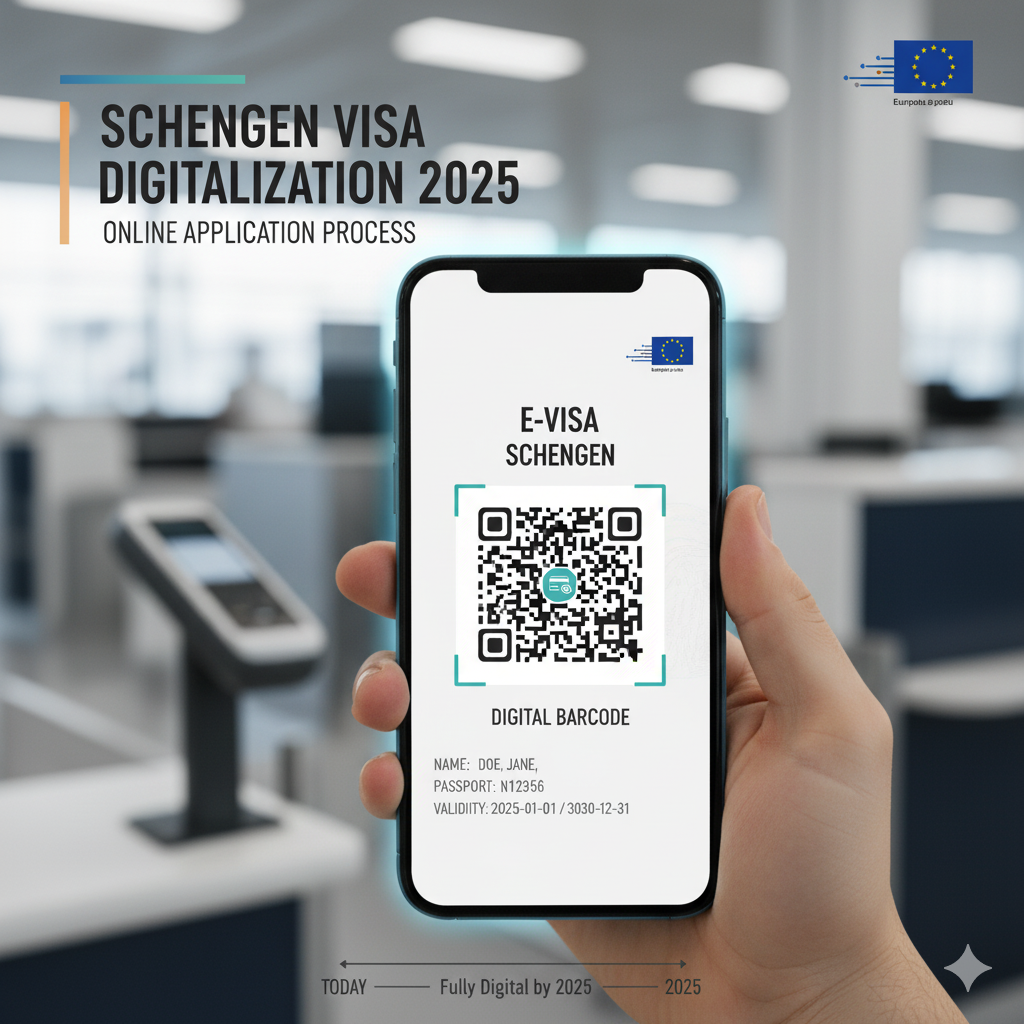
Member Countries:
Austria, Belgium, Croatia, Czech Republic, Denmark, Estonia, Finland, France, Germany, Greece, Hungary, Iceland, Italy, Latvia, Lithuania, Luxembourg, Malta, Netherlands, Norway, Poland, Portugal, Slovakia, Slovenia, Spain, Sweden, Switzerland, Liechtenstein.
5. Schengen Visa Digitalization 2025 Fees and Payment Updates
One of the most discussed updates under Schengen Visa Digitalization 2025 is the revised fee structure.
| Category | Old Fee | New Fee (2025) | Remarks |
|---|---|---|---|
| Adults | €80 | €90 | Standard short-stay visa |
| Children (6–12 years) | €40 | €45 | Slight adjustment |
| Under 6 years | Free | Free | No change |
| Long-stay / multiple entry | Variable | EU-based decision | Subject to member state |
Tip: Always apply directly through the official EU Visa Portal to avoid third-party scams.
6. Processing Time: Faster and More Transparent
Previously, Schengen visa approvals could take 15–30 days depending on the country.
With digital applications, processing is expected to take 10–15 working days, or even faster during low season.
Applicants will also get real-time tracking updates through email or the EU visa dashboard.
7. Biometric and Security Enhancements
Even though applications are online, biometric verification (fingerprints + photo) remains mandatory for first-time applicants.
Once recorded, your biometric data stays valid for 59 months, meaning you won’t need to visit a center again for five years.
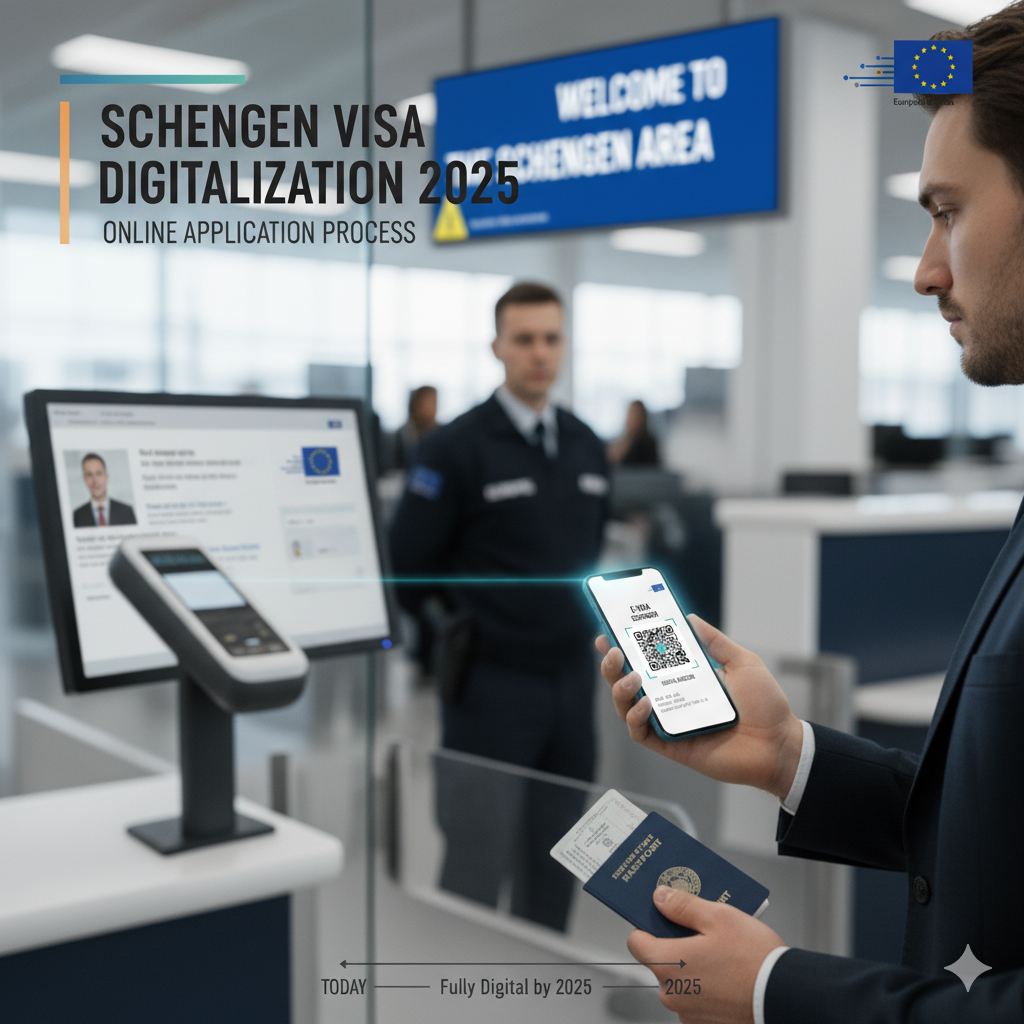
Additionally, QR-coded visas allow airlines and border authorities to instantly verify validity and authenticity — no more missing stickers!
8. Who Benefits from the Schengen Visa Digitalization 2025 ?
- Frequent travelers benefit from faster repeat applications
- Business professionals enjoy smoother entry for conferences and meetings
- Tourists can plan trips without embassy delays
- Students and digital nomads get more flexibility
This reform especially helps travelers from Asia, Africa, and Latin America, who previously faced lengthy visa queues.
9. Impact on Global Mobility
By embracing digital visas, Europe joins countries like Australia (ETA), U.S. (ESTA), and UK (ETA) in making border entry systems more efficient and data-secure.
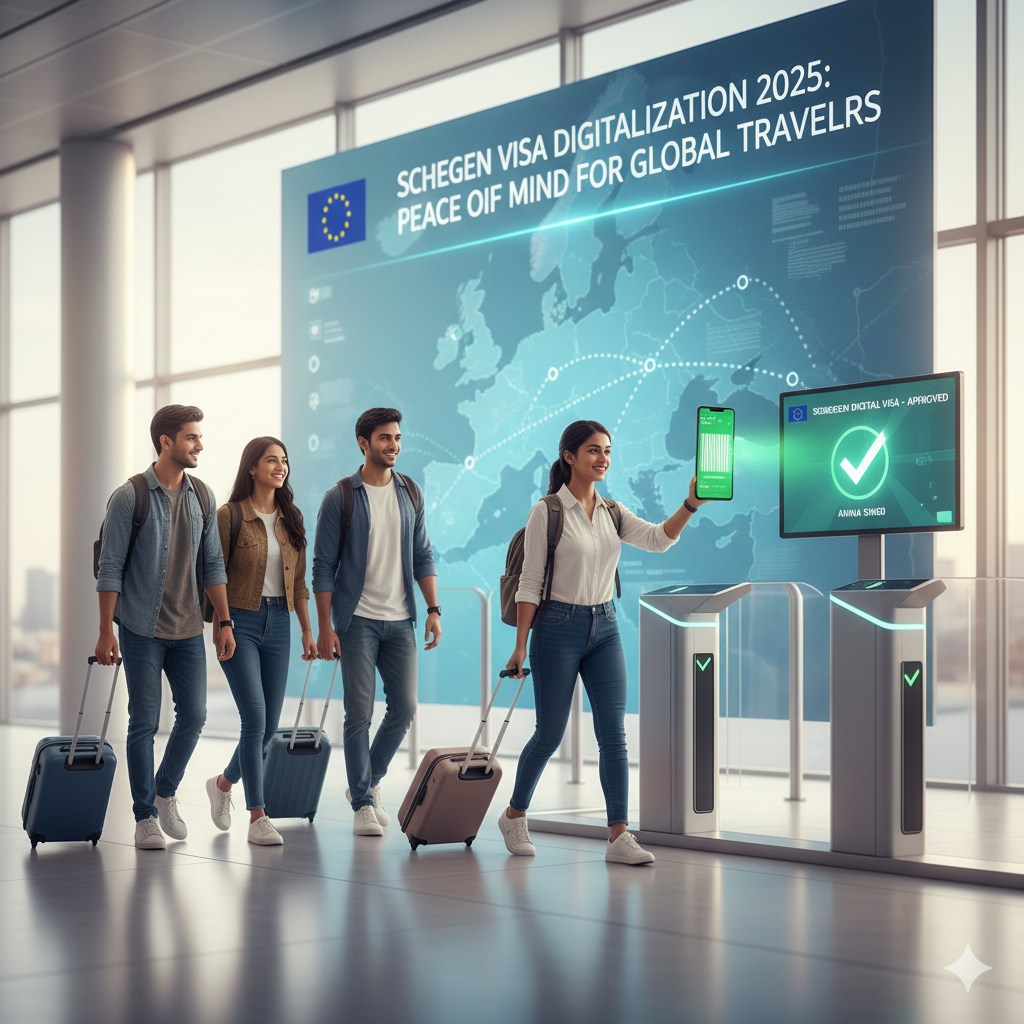
For travelers, this means:
- Faster travel planning
- Eco-friendly process (no paper or stickers)
- Global recognition of digital entry systems
10. Tips for Applying for a Schengen Visa Digitalization 2025 Online
- Use only official EU websites — avoid third-party “agents.”
- Prepare digital copies of your documents before starting.
- Double-check your travel insurance coverage dates.
- Apply at least 20 days before your trip.
- Always confirm new country-specific updates via official embassy pages.
Frequently Asked Questions Schengen Visa Digitalization 2025
1. When will Schengen Visa Digitalization start?
Implementation begins mid-2025, with gradual rollout across all Schengen countries.
2. Will I still need to visit a visa center?
Only for first-time biometric registration. Repeat travelers can complete everything online.
3. How will I receive my digital visa?
As a secure QR code linked to your passport number via the EU Visa Portal.
4. Will this affect visa validity or stay limits?
No, standard 90-day stay within 180 days rule remains unchanged.
5. Can I still use third-party websites?
It’s not recommended — only apply through the official EU website to avoid fraud.
Agent Advise: The Future of Schengen Travel Is Digital
The Schengen Visa Digitalization 2025 is more than just a modernization effort — it’s a gateway to smarter, safer, and faster global travel.
By introducing a unified online system, Europe is redefining how millions experience visa applications.
Whether you’re a frequent business traveler, digital nomad, or first-time tourist, this innovation ensures less waiting, fewer papers, and more travel freedom.
“The world is opening up digitally — and Europe is leading the way.”

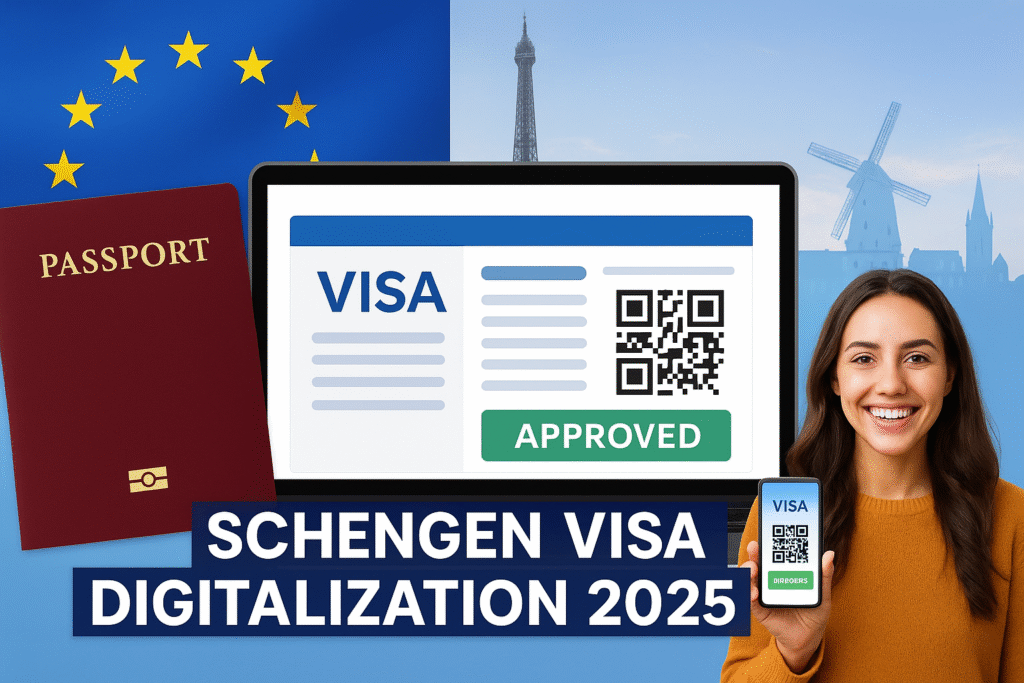
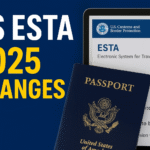

Pingback: Australia ETA 2025: Faster Processing & New App Updates
Pingback: Amazing Canada eTA vs Visitor Visa 2025: Comparison Guide
Pingback: Exciting New Visa-Free Countries for Chinese Passport 2025
Pingback: Schengen Visa Rejection 2025 New Appeal Rules
Pingback: Biometric Exit Systems 2026: Powerful Global Rollout
Pingback: Facial Recognition Borders 2026: Powerful No-Passport Travel